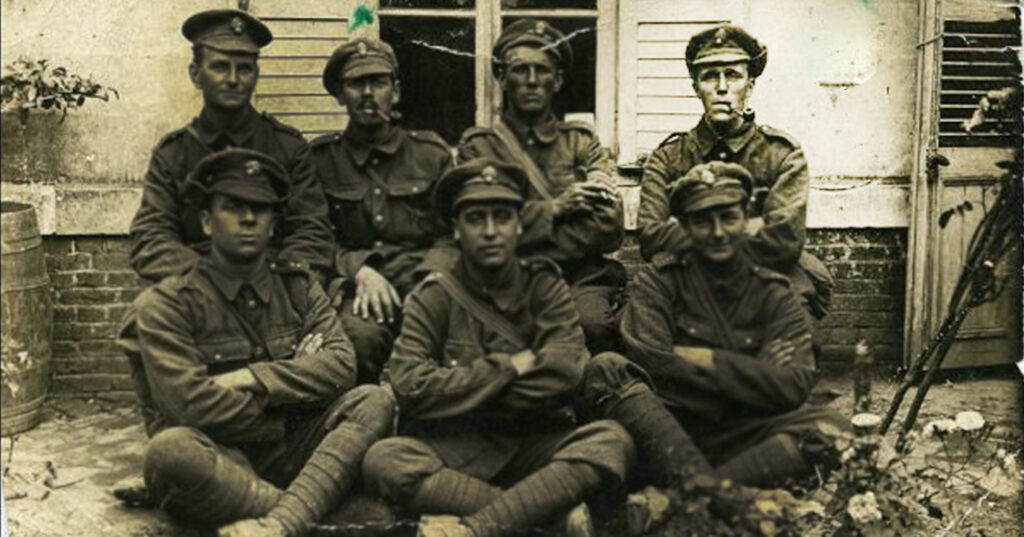
Published in Britain at War in April 2017.
Wing Commander Frederick William Palmer VC, MM: initiative
Frederick William Palmer was born in Hammersmith, west London, on 11 November 1891. He was the son of Thomas Palmer, a taxicab owner, and his wife Rhoda (née Smith). By 1914, the year he married Daisy Dightam, Palmer was working for a publishing company. After the outbreak of the Great War in August 1914, he enlisted as a private into the 22nd Battalion, The Royal Fusiliers (City of London Regiment).
Shortly after his 24th birthday, Palmer left for France on 16 November 1915 and was present at both Delville Wood and Redan Ridge.
By early 1917, Palmer was back in France and in February the British began to press north from Courcelette, close to the Albert-Bapaume road. It was part of the area that had been seized by the enemy during the Battle of the Somme. Christopher Stone, the regimental historian, described the land as “desolate, treeless, a mass of mine craters, shell holes and wire entanglements…”
On 16/17 February, the 22nd and 23rd Royal Fusiliers (99th Brigade, 2nd Division) were involved in heavy fighting that left 85 men dead. D Company from the 22nd Battalion had come under intense fire because the enemy had been alerted to their early morning attack on 17 February by deserters. It was during the height of the battle that Palmer, by then a lance sergeant, showed such outstanding bravery that he was later awarded the VC. The citation for his decoration, announced on 3 April 1917, stated:
“For most conspicuous bravery, control and determination.
“During the progress of certain operations, all the Officers of his Company having been shot down, Sjt. Palmer assumed command, and, having cut his way under point blank machine gun fire, through the wire entanglements, he rushed the enemy’s trench with six of his men, dislodged the hostile machine gun which had been hampering our advance, and established a block.
“He then collected men detached from other regiments, and held the barricade for nearly three hours against seven determined counter-attacks, under an incessant barrage of bombs and rifle grenades from his flank and front.
“During his temporary absence in search of more bombs an eighth counter-attack was delivered by the enemy, who succeeded in driving in his party, and threatened the defences of the whole flank. At this critical moment, although he had been blown off his feet by a bomb and was greatly exhausted, he rallied his men, drove back the enemy and maintained his position.
“The very conspicuous bravery displayed by this Non-commissioned Officer cannot be overstated, and his splendid determination and devotion to duty undoubtedly averted what might have proved a serious disaster in this sector of the line.”
Palmer’s wounds from the battle were not serious and on 25/26 April, by then commissioned as a second lieutenant, he was back in the thick of the fighting during an attack on the enemy-held Oppy Wood. At one point, he had to hide in a shell-hole in the enemy wire to avoid the heavy fire. Once again, there were heavy casualties and on this occasion the wood remained in enemy hands.
Palmer received both his VC and the MM, for earlier acts of bravery, from King George V at an investiture in Hyde Park on 2 June 1917. A month later, on 11 July, he was asked to attend a Special Meeting of the Council of the Metropolitan Borough of Hammersmith, where he grew up. Clearly nervous, Palmer received a rousing reception and was asked to inscribe his name on the borough’s Roll of Honour.
During his visit, Palmer told the audience that it was impossible to comprehend what life was like for troops in France and Belgium, and he urged them to write to people they knew on the frontline at least once a week as it would cheer them up. He also said that a regular parcel would be most welcome.
After the war, Palmer was transferred to the RAF as a lieutenant. After being demobbed, he became a planter in Malaya and lived in Singapore. He also worked as a director of Kyle, Palmer & Co, printers and publishers. After the death of his first wife, who bore him a son, he remarried: on Christmas Eve 1937, he wed Doris Kimsinn, the daughter of a Chinese magistrate, at St Mary’s Church, Kuala Lumpur, Malaya, and the couple went on to have a son and two daughters.
After the outbreak of the Second World War, Palmer returned to England and was granted a commission in the Royal Air Force Volunteer Reserve (RAFVR). As a pilot officer in the Administrative Special Duties Department, he served in the ground defence forces from 1940-5, and was eventually promoted to wing commander. He was Mentioned in Despatches for his courageous actions.
However, his family home was destroyed by fire in 1942 when the Japanese overran Singapore. His wife, who had been working as a nurse in Singapore during the war, and their then two young children were driven north and taken to a refugee camp. Palmer heard no news of them for nearly four years but they were released at the end of the war.
The family was eventually reunited and went to live in Hordle, Hampshire. Palmer died in Lymington Hospital, Hampshire, on 10 September 1955, aged 63, leaving a widow and three children from his second marriage. He was cremated and his ashes were buried at All Saints churchyard, Hordle.
I do not own Palmer’s medal group: instead in June 2006, his family presented them on loan to the Royal Fusiliers Museum, and they went on public display at the Tower of London.
Download a PDF of the original Britain at War article
For more information, visit:
LordAshcroftOnBravery.com


